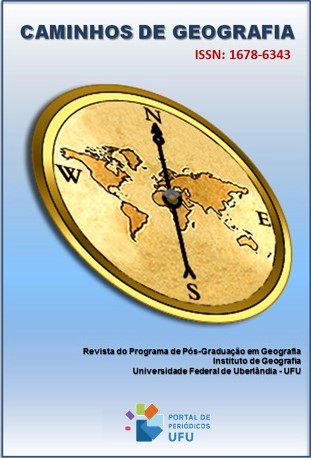MODELOS PALEOCLIMÁTICOS E FORMAS DE RELEVO NO QUATERNÁRIO: IMPLICAÇÕES GEOMORFOLÓGICAS NO SETOR CONTINENTAL DA BAHIA
DOI:
https://doi.org/10.14393/RCG249162238Palavras-chave:
Paleogeomorfologia, Paleoclimatologia, Datação, Compartimentos do RelevoResumo
Em setores específicos da Bahia, modelos paleoclimáticos desenvolvidos nas duas últimas décadas contribuíram para elucidar questões relacionadas às variações nas condições de umidade durante o Quaternário. Da mesma forma, dinâmicas geomorfológicas pretéritas, investigadas em diferentes contextos do estado, corroboraram para o avanço nas discussões sobre a evolução do relevo, apontadas de maneira genérica na literatura clássica. Nesse artigo, objetivou-se avaliar a contribuição de pesquisas desenvolvidas no setor continental baiano, no sentido de compreender a morfogênese regional quaternária, no contexto dos grandes compartimentos do relevo. A sistematização e espacialização dos proxies utilizados em literaturas anteriores contribuíram para a identificação de três períodos conhecidos na escala do Quaternário, que demonstraram a relação entre períodos úmidos/secos e as respostas do relevo às diferentes condições de umidade. Da mesma forma, quatro gaps temporais foram identificados, os quais necessitam de futuras investigações que visem a complementar as informações sobre o setor pesquisado.
Downloads
Downloads
Publicado
Edição
Seção
Licença
Copyright (c) 2023 Kleber Carvalho Lima, Cenira Maria Lupinacci, Pedro Ítalo Carvalho Aderaldo

Este trabalho está licenciado sob uma licença Creative Commons Attribution-NonCommercial-NoDerivatives 4.0 International License.
Autores que publicam nesta revista concordam com os seguintes termos: a) Autores mantém os direitos autorais e concedem à revista o direito de primeira publicação, com o trabalho licenciado sob a Creative Commons Atribuição-NãoComercial-SemDerivações 4.0 Internacional. b) Autores têm permissão e são estimulados a publicar e distribuir seu trabalho online (ex.: em repositórios institucionais ou na sua página pessoal), já que isso pode gerar alterações produtivas, bem como aumentar o impacto e a citação do trabalho publicado. c) Em virtude de aparecerem nesta revista de acesso público, os artigos são de uso gratuito, com atribuições próprias, em aplicações educacionais e não-comerciais.











